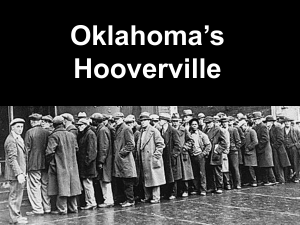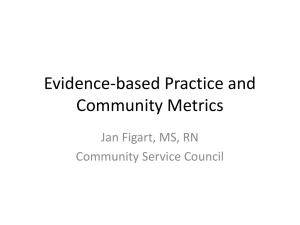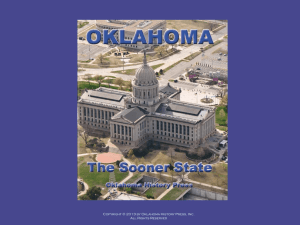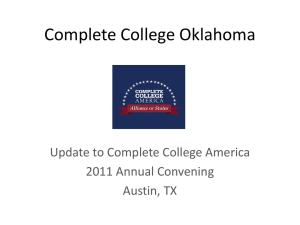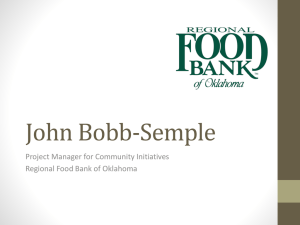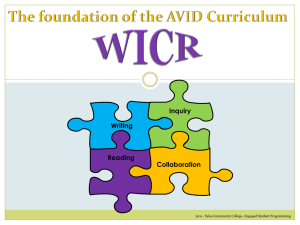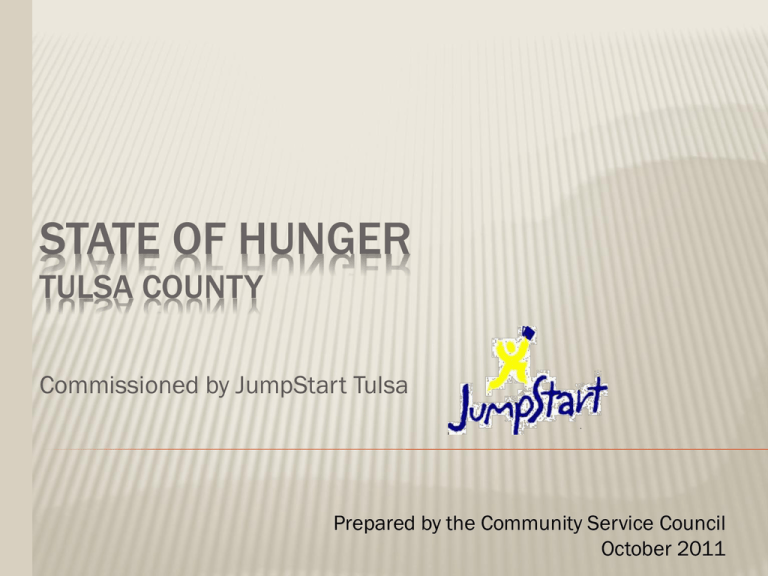
STATE OF HUNGER
TULSA COUNTY
Commissioned by JumpStart Tulsa
Prepared by the Community Service Council
October 2011
TULSA COUNTY
Demographic Trends
Economics
Health Indicators
Demographics
DEMOGRAPHIC TRENDS
DEMOGRAPHIC TRENDS
Population change--migration to suburban
areas of Tulsa and Oklahoma City MSA with an
overall decrease in new births
Age--aging population
Race and ethnicity--more culturally diverse
Living arrangements--transitional for family
living arrangement
Demographics
Race Comparison for Total Population and Children under
Oklahoma and Tulsa County, 2010
Tulsa County
Oklahoma
59.3%
19.8%
22.8%
54.9%
Demographics
Under 5
2.5%
7.3%
1.6%
Hispanic
16.8%
11.0%
8.2% N = 266,547
Hispanic
20.6%
12.6%
N = 48,035
69.2%
72.2%
Total
Population
10.1%
11.7%
1.7%
2.3%
8.6%
Hispanic
8.9%
White
7.4%
N = 3,642,361
Black
American Indian
6.0%
10.7%
N = 591,982
Hispanic
11.0%
Asian
Other/2+ races
Source: US Census Bureau, 2010 Census.
Prepared by the Community Service Council of Greater Tulsa
Population Trends and Projections by Age Group
Demographics
Projections
Tulsa County, 1970 - 2030
2030 6.3
16.6
2020
6.6
17.1
9.7
2010
6.8
18.2
10.1
52.5
10.6
1.9
2000
7.4
18.9
10
51.9
10.4
1.4
1990
7.7
18.4
10.1
52.2
10.4
1.2
1980
7.7
19.8
9
.9
1970
8.5
8.1
.6
0%
9.2
47.8
50.5
13.5
25.9
20%
17.5
2.1
14.1
49.1
10.7
40%
2.5
46.2
60%
80%
100%
Percent of population
0-4
5-17
18-24
25-64
65-84
85+
Source: US Census Bureau, 1970, 1980, 1990, & 2000 Censuses; US Census Bureau, Population Estimates Division,
Population Projections, 2000 - 2030.
Prepared by the Community Service Council of Greater Tulsa
Living Arrangements of Related Children Under 18
Tulsa County, 1970, 1980, 1990, 2000 & 2005-07 Estimates
100%
1970
1980
1990
2000
2005-07 est.
80%
Demographics
60%
40%
20%
0%
1970
1980
1990
2000
2005-07 est.
Married Couple
Male-headed
Female-headed
Other relatives
82%
74%
71%
65%
61%
1%
2%
3%
5%
6%
11%
16%
18%
21%
25%
4%
6%
5%
7%
8%
Children living with 1 or both parents
Source: US Census Bureau, 1970, 1980, 1990, and 2000 Censuses; US Census Bureau, American Community Survey
2005-07.
Prepared by the Community Service Council of Greater Tulsa
ECONOMICS AND EMPLOYMENT
Ratio of Income to Poverty Level
Percentage of Total Population and Children
Tulsa County, 2005-09
Percentage of population
Below 100%
75%
Below 185%
Below 200%
50%
25%
0%
Below 100%
Below 185%
Below 200%
Total population
19.8%
41.6%
45.4%
Under 18
22.2%
42.1%
45.4%
Source: US Census Bureau, 2005-09 American Community Survey.
Under 6
26.8%
47.9%
51.1%
6-17
19.6%
38.7%
42.1%
Comparison of Wages: Self-Sufficiency, Welfare, Minimum,
Poverty, 185% of Poverty, and Median Family Income
Family of Three, Tulsa County, 2010*
Annual Wage
Economics & Employment
$80,000
$73,324
($34.72/hr)
$60,000
Self-Sufficiency Wage = $39,978
Married-couple
families w/
children <18
($18.93/hr)
$52,870
($25.03/hr)
$40,000
$33,874
$20,000
$15,312
$10,309
$0
$36,832
($17.44/hr)
$21,551
$18,310
($10.20/hr)
($4.88/hr)
($7.25/hr)
($8.67/hr)
($16.04/hr)
Welfare
Wage
Minimum
Wage
Poverty
Wage
185% Poverty
Wage
All families w/
children <18
Male-headed
families w/
children <18
Female-headed
families w/
children <18
Median Family
Income
(2006-08 ACS)
Notes: For the self-sufficiency wage, family of three consists of one adult, one preschooler and one schoolage child. Hourly wages given assume
full-time, year-round employment. The 2009 poverty guidelines are being used until at least March 1, 2010. Welfare wage is the combined value
of TANF, SNAP, & WIC.
Source: Oklahoma Association of Community Action Agencies and the Oklahoma Asset Building Coalition, December 2009, The Self-Sufficiency
Standard for Oklahoma 2009; 2009 HHS Poverty Guidelines, Federal Register, Vol. 74, No. 14, January 23, 2009, p. 4200; Oklahoma State
Dept. of Human Services; U.S. Census Bureau, 2006-08 American Community Survey.
Participation in Public Assistance Programs
Number of Participants and Percentage of Population Participating
Tulsa County, 2011
21.5%
Economics & Employment
Soonercare Total (185%/100%) (8/11)129,750
44.9%
73,002
Soonercare <19 (185%) (8/11)
47.1%
4,152
WIC Infants (185%) (8/11)
22.3%
9,972
WIC age 1-5 (185%) (8/11)
9.5%
4,231
Child Care Subsidy <5 (185%) 6/11)
14.6%
87,852
SNAP Total (130%) (6/11)
1.6%
2,533
TANF <18 (50%) (6/11)
Elem. School Free Lunch (130%)
(SY 2010-11)
52.8%
31,732
Elem. School Reduced Lunch (185%)
(SY 2010-11)
8.2%
4,946
150,000
100,000
50,000
Number of Participants
0%
0
20%
40%
60%
Percent of Population
Source: Oklahoma Dept. of Human Services, Statistical Bulletin, June 2011; Oklahoma State Dept. of Education, Low Income Report for 2010-11;
US Census Bureau, 2010 Census; Oklahoma State Department of Health-WIC Service, Caseload Report, August 2011.
Prepared by the Community Service Council of Greater Tulsa
Educational Attainment for Persons Age 25 & Older
Tulsa County, 2006-08 Estimates
15.1%
Economics & Employment
Less than
high school
33%
High school
graduate
22.8%
Some
college
6.7%
Associate
degree
15.1%
Bachelor's
degree
5.1%
Master's
degree
1.4%
Professional
school degree
0.8%
Doctorate
degree
0%
10%
20%
Percent of persons 25+
Source: US Census Bureau, American Community Survey 2006-08.
Prepared by the Community Service Council of Greater Tulsa
30%
40%
HEALTH INDICATORS
WHAT IS OKLAHOMA’S RISK FOR HUNGER?
Child Indicators
8th in the nation per capita of people hungry
13% of population food insecure compared to 11.3%
nationally
1 in 5 children and 1 in 3 elderly are food insecure
32 of 77 counties are food deserts with at least 25 percent
of the population living ten miles or more from a
supermarket or supercenter
9 of those counties are "severe food deserts," meaning that
the entire population has limited access to such food
outlets. These counties are Cimarron, Dewey, Ellis, Grant,
Greer, Harmon, Harper, Hughes and Jefferson Counties.
Oklahoma loses an estimated $1.4 billion each year from
hunger through illness, increased illness and decreased
academic achievement alone.
(Oklahoma Food Bank Network, (2010). Retrieved http://www.hungerinoklahoma.org/facts.html)
Prepared by the Community Service Council of Greater Tulsa
THE ADVERSE CHILDHOOD EXPERIENCES (ACE)
STUDY PYRAMID
Death
Early Death
Child Indicators
Disease,
Disability and
Social Problems
Adoption of Health-risk
Behaviors
Social, Emotional and Cognitive
Impairment
Disrupted Neurodevelopment
Adverse Childhood Experiences
Conception
Mechanisms by which Adverse Childhood Experiences Influence
Health and Well-being throughout the Lifespan
Source: The Adverse Childhood Experiences Study website: www.acestudy.org, “About the Adverse Childhood
Experiences Study.”
ADVERSE CHILDHOOD EXPERIENCES…
Child Indicators
…GROWING UP IN A HOUSEHOLD WITH:
Recurrent physical abuse
Recurrent emotional
abuse
Sexual abuse
An alcohol or drug
abuser
An incarcerated
household member
Someone who is
chronically depressed,
suicidal, institutionalized
or mentally ill
Mother being treated
violently
One or no parents
Emotional or physical
neglect
Source: The Adverse Childhood Experiences Study website: www.acestudy.org, “What are Adverse Childhood
Experieinces (ACE’s).”
Child Indicators
…LEAD TO HEALTH-RISK BEHAVIORS…
Smoking
Overeating
Physical inactivity
Heavy alcohol use
Drug use
Promiscuity
Source: The Adverse Childhood Experiences Study website: www.acestudy.org
…WHICH CAUSE DISEASE, DISABILITY AND SOCIAL
PROBLEMS IN ADULTHOOD
Child Indicators
Nicotine addiction
Alcoholism
Drug addiction
Obesity
Depression
Suicide
Injuries
Unintentional pregnancy
Heart disease
Cancer
Chronic lung and liver
disease
Stroke
Diabetes
Sexually transmitted
diseases
Source: Felitti, Vincent J., “The Relationship of Adverse Childhood Experiences to Adult Health: Turning gold into lead;”
CDC Media Relations, May 14, 1998, “Adult Health Problems Linked to Traumatic Childhood Experiences.”
Summary of Risk Factors for Infants
Tulsa County and Oklahoma, 2008
12.1%
13.7%
Teen mother
(age 15-19)
43.9%
42.3%
Unmarried mother
8%
5.4%
Child Indicators
Poor prenatal care
(3rd trimester/no care)
23.2%
21.4%
Mother w/ <12th grade
education
Tulsa Co.
Oklahoma
7%
6.9%
Low birthweight
(1500-2499 grams)
1.8%
1.4%
Very low birthweight
(<1500 grams)
31.5%
34.8%
Short birth spacing
(<24 mos. apart)
17.6%
20.5%
Very short birth spacing
(<18 mos. apart)
12.2%
11%
Premature
(<37 weeks gest.)
0%
10%
20%
Tulsa County births: 9,530
Oklahoma births:
54,753
30%
Percent of Births
Source: Oklahoma State Department of Health, Vital Statistics.
Prepared by the Community Service Council of Greater Tulsa
40%
50%
Child Deaths Due to Abuse
Oklahoma, Fiscal Years 1978 - 2007
60
51
50
45
47 48
38
40
31
31
24
21
18
20
16 16
23
25
39
35
34
30
40
38
32
29
27
23
18
20
12 13
10
0
7
5
1978
1979
1980
1981
1982
1983
1984
1985
1986
1987
1988
1989
1990
1991
1992
1993
1994
1995
1996
1997
1998
1999
2000
2001
2002
2003
2004
2005
2006
2007
Child Indicators
42
Source: Oklahoma Dept. of Human Services, Children & Family Services Division.
Prepared by the Community Service Council of Greater Tulsa
Child Indicators
CHILD ABUSE & NEGLECT
In Tulsa County in FY 2009, there were 3,933 reports of child abuse and/or
neglect accepted for investigation or assessment. 6,583 children were involved
in these reports (duplicated count).
1,248 children were confirmed victims of child abuse and/or neglect. 89 were
abused, 992 were neglected, 167 were victims of both abuse and neglect.
Eight of every 1,000 children in Tulsa County are victims of abuse and/or
neglect. In Oklahoma, the rate is 10 of every 1,000 children.
Oklahoma ranks #35 in the nation in the rate of children who are victims of
abuse and/or neglect.
Parents make up 73.7% of all perpetrators, followed by “no relation” at 6.9%,
step-parents at 5.9%, and grandparents at 3.5%.
Substance abuse is a major contributing factor to child neglect.
Prepared by the Community Service Council of Greater Tulsa
Age of Children of Confirmed Abuse and Neglect
Oklahoma, FY 2009
1-2
1,480 (17.2%)
Child Indicators
Under 1
1,492 (17.3%)
3-6
2,351 (27.3%)
12 & older
1,399 (16.3%)
7-11
1,883 (21.9%)
Source: Oklahoma Dept. of Human Services, Children & Family Services Division.
Prepared by the Community Service Council of Greater Tulsa
Elementary School Students Eligible for Free and
Reduced Lunch Program
By School District, Tulsa County, 2010-2011 School Year
Tulsa County Total
52.8%
8.2%
Tulsa
78.2%
Child Indicators
Sperry
8.3%
64.5%
7%
Keystone
50.1%
17.2%
Sand Springs
51.4%
13.6%
Liberty
50.7%
12.1%
Union
51.6%
9.7%
Glenpool
40.1%
Skiatook
12.3%
43.1%
Collinsville
Broken Arrow
31%
Berryhill
29.9%
12%
7.4%
7.4%
Owasso
24.7%
7.4%
Jenks
26.3%
5.4%
Bixby
20.5%
0%
Free lunch eligibility
requirement: annual household
income below 130% of poverty,
which currently is $24,089 for a
family of three.
8.6%
31.5%
Reduced lunch eligibility
requirement: annual household
income below 185% of poverty,
which currently is $34,281 for a
family of three.
4.2%
20%
Free
Reduced
40%
60%
80%
Percent of Students Eligible
Source: Oklahoma State Dept. of Education, Low Income Report for 2009-2010.
Prepared by the Community Service Council of Greater Tulsa
100%
Youth Risk Behavior Survey:
Summary of Alcohol, Other Drug & Tobacco Use
High School Students, Oklahoma, 2003 through 2009, and U.S., 2007
47.8%
40.5%
43.1%
39%
44.7%
Alcohol
Child Indicators
Used once or
more during
past 30 days...
Ever
used...
22%
18.7%
15.9%
17.2%
19.7%
Marijuana
9.9%
7.1%
5.5%
4.8%
4.4%
Methamphetamine
22.2%
18.4%
19.1%
16.8%
22.3%
26.5%
28.6%
23.2%
22.6%
20%
17.5%
12.3%
13.3%
11%
10.5%
30.6%
25.8%
26.8%
23.1%
29.1%
Offered/sold/given
illegal drugs at school
Smoked cigarettes
during past month
Drove after drinking
alcohol in past month
Rode with drinking
driver in past month
0%
20%
40%
2003 Oklahoma
2005 Oklahoma
2007 Oklahoma
2009 Oklahoma
2007 US
60%
80%
Note: National 2009 YRBSS data have not yet been released.
Source: Centers for Disease Control, Youth Risk Behavior Surveillance System; Oklahoma State Department of Health,
OK2SHARE.
Prepared by the Community Service Council of Greater Tulsa
100%
Youth Risk Behavior Survey:
Summary of Sexual Behaviors, Suicide & Physical Health
High School Students, Oklahoma, 2003 through 2009, and U.S., 2007
50%
49.3%
50.9%
51.1%
47.8%
Ever had
sexual intercourse
5.8%
6.5%
5.8%
4.7%
7.1%
Child Indicators
Had sex before age 13
64.3%
61.7%
59.6%
56.7%
61.5%
Used condom last time
17.7%
16.4%
16.7%
22.7%
16%
Used birth control
pills last time
7%
7.9%
5.9%
7%
6.9%
Attempted suicide
in past year
Overweight
(according to BMI)
Physical activity for
60 min/day 5 of past 7 days
2003 Oklahoma
2005 Oklahoma
2007 Oklahoma
2009 Oklahoma
2007 US
14.2%
15.9%
15.2%
16.4%
15.8%
na
38.2%
34.7%
0%
20%
40%
49.6%
47.4%
60%
80%
Note: National 2009 YRBSS data have not yet been released.
Source: Centers for Disease Control, Youth Risk Behavior Surveillance System; Oklahoma State Department of Health,
OK2SHARE.
Prepared by the Community Service Council of Greater Tulsa
100%
Health Status
Percent adults reporting fair or poor health
25%
50
Oklahoma
Rank
US
20%
40
15%
30
10%
20
5%
10
0%
0
'96 '97 '98 '99 '00 '01 '02 '03 '04 '05 '06 '07 '08 '09
US 12.9% 12.9% 12.8% 12.6%
13% 13.9%
14% 14.7% 14.7% 14.9% 14.8% 14.7% 14.9% 14.4%
Rank
26
32
28
25
42
34
45
41
41
44
42
46
43
42
Oklahoma 13.1%
14% 13.4% 12.6% 17.4% 15.3% 19.6% 17.7% 17.8% 19.7% 18.7% 20.2% 19.2% 18.7%
Source: United Health Foundation, “America’s Health Rankings.“
Prepared by the Community Service Council of Greater Tulsa
State rank
Child Indicators
Oklahoma and United States, 1996 - 2009
Prevalence of Obesity
Oklahoma and United States, 1990 - 2009
Percent of population estimated to be obese
50
Oklahoma
Rank
US
30%
40
25%
30
20%
15%
20
10%
10
5%
0%
0
'90 '91 '92 '93 '94 '95 '96 '97 '98 '99 '00 '01 '02 '03 '04 '05 '06 '07 '08 '09
Source: United Health Foundation, “America’s Health Rankings.“
Prepared by the Community Service Council of Greater Tulsa
State rank
Child Indicators
35%
Prevalence of Smoking
Percent of population over 18 that smoke regularly
60%
60
Oklahoma
Rank
US
50%
50
40%
40
30%
30
20%
20
10%
10
0%
0
'90 '91 '92 '93 '94 '95 '96 '97 '98 '99 '00 '01 '02 '03 '04 '05 '06 '07 '08 '09
Source: United Health Foundation, “America’s Health Rankings.“
Prepared by the Community Service Council of Greater Tulsa
State rank
Child Indicators
Oklahoma and United States, 1990 - 2009
Health Insurance Status, by Age
Oklahoma, 2007-2008
Total Population
Under Age 19
101,000 (10.4%)
38,600 (4.0%)
564,700 (16.0%)
Child Indicators
1,714,100 (48.5%)
590,500 (16.7%)
456,300 (47.0%)
337,000 (34.7%)
505,000 (14.3%)
156,600 (4.4%)
457,500 (22.1%)
38,900 (4.0%)
2,900 (0.6%)
21,700 (4.4%)
2,300 (0.5%)
6,200 (1.3%)
96,800 (4.7%)
146,300 (7.1%)
1,255,500 (60.6%)
114,800 (5.5%)
Age 19-64
Employer
Individual
455,100 (93.2%)
Age 65 & ov er
Medicaid
Medicare/Other Public
Source: Kaiser Family Foundation.
Prepared by the Community Service Council of Greater Tulsa
Uninsured
Oklahoma's Rankings in Health Determinants,
2010 (part 1)
According to United Health Foundation's State Health Rankings
1990
Personal Behav iors
2010
Prevalence of smoking
#48
Prevalence of Binge Drinking
#10
Prevalence of obesity
#46
Community & Env ironment
High school graduation
#23
Violent crime
#40
Occupational fatalities
#44
Infectious disease
#28
Children in poverty
#31
Air pollution
#24
#0
#10
#20
#30
Ranking: 1=best, 50=worst
Source: United Health Foundation, “America’s Health Rankings.“
#40
#50
Oklahoma's Rankings in Health Determinants,
2010 (part 2)
According to United Health Foundation's State Health Rankings
1990
Public & Health Policies
2010
Lack of health insurance
#35
Public health funding (per capita)
#14
Immunization coverage
#18
Clinical Care
Early prenatal care
#47
Primary Care Physicians
#49
Preventable Hospitalizations
#46
All Determinants
#45
#0
#10
#20
#30
Ranking: 1=best, 50=worst
Source: United Health Foundation, “America’s Health Rankings.“
#40
#50
Oklahoma's Rankings in Health Outcomes,
2010
According to United Health Foundation's State Health Rankings
Oklahoma’s overall health ranking for 2010 is
1990
Poor mental health days
# 46
2010
#48
Poor physical health days
#46
Geographic disparity
#21
Infant mortality
#44
Cardiovascular deaths
#48
Cancer deaths
#40
Premature death
#46
All Health Outcomes
#46
#0
#10
#20
#30
Ranking: 1=best, 50=worst
Source: United Health Foundation, “America’s Health Rankings.“
#40
#50
…IN SUMMARY
STATE OF HUNGER
TULSA COUNTY
Prepared by the Community Service Council of Greater Tulsa
October 2011
…is available on our website:
www.csctulsa.org


